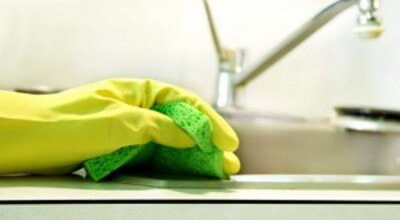Even the cleanest homes have billions of germs, but some places in your home are far worse than others. In a recent germ study, microbiologists from National Sanitation Foundation (NSF) discovered that six of the dirtiest places in the home were in the kitchen. Below are the top 10 dirtiest places, along with tips for cleaning.
1. Dish sponges and scrubbers. According to NSF, the sponge or scrubber in your kitchen sink is the dirtiest place in your home and probably contains both E. coli and salmonella. The study found that after three weeks of use, 70 percent of sponges contained bacteria. To kill germs, place sponges in the microwave for two minutes. You should replace them at least every two weeks.
2. Kitchen sink. NSF found that because of the frequent contact it has with food, your kitchen sink may be 100,000 times more contaminated than your bathroom sink. Your toilet may be cleaner than your kitchen sink, says Eileen Abruzzo, director of infection control at Long Island College Hospital of Brooklyn, N.Y. What should you do? Thoroughly scrub the entire surface once or twice a week with hot water and soap.
3. Toothbrush holder. This was the third “germiest” area in the study. According to NSF, the average toothbrush holder is crawling with more than 2 million cells of bacteria. Research by Charles P. Gerba, Ph.D., of the University of Arizona, found that flushing the toilet sends a spray of bacteria into air, which can float around the bathroom for at least two hours before landing on surfaces. Not only should you clean your toothbrush holder thoroughly once or twice a week, but it’s also best to purchase one made from stainless steel or plastic.
4 and 7. Pet bowl and toys. Pet dishes and toys were a source of coliform, staph, yeast and mold in many homes. These items should be washed daily, either in a sanitizing dishwasher or scrubbed by hand with hot, soapy water. Soft toys should be washed at least monthly with other laundry on the hot water cycle.
5. Coffee maker. According to NSF, bacteria and mold thrive in the dark and damp areas of your coffee maker. Cleaning the inside every couple of month (assuming you use it every day) will not only keep it clean but also improve the taste. Fill the water reservoir with about four cups of vinegar and let sit for 30 minutes. Then turn it on and allow the vinegar to cycle through. Finally, run two or three additional cycles with water until the vinegar odor fades.
6. Faucet handles. Faucet handles in both the kitchen and bath contained coliform bacteria as well as yeast mold. You should clean them daily with non-toxic disinfecting cleaner or nontoxic disinfecting wipes.
8. Kitchen countertops. This high-traffic area collects germs all day long from purses, grocery bags, various raw food containers, dishes and more. Kitchen surfaces should be washed at least daily and after every meal with hot, soapy water.
9. Stove dials. The controls that adjust your stove’s heat are some of the filthiest places in your home. This is because you constantly touch them while handling food. Check your stove’s manual to be safe, but you should be able to remove the dials and either put them in the dish water or wash them with warm, soapy water.
10. Showers and bathtubs. Finally, the NSF found the bacteria staphylococci in 26 percent of the bathtubs and showers they studied. This bacteria causes various staph infections, including those in the urinary tract. The best practice is to use a natural, nontoxic and nonabrasive tub and shower spray daily.
Other common sources of bacteria include TV remotes, salt shakers, keyboards, cell phones, makeup bags, light switches and the interior of the refrigerator. According to the Centers for Disease Control, bacteria and viruses can live two hours or longer on most home surfaces—much longer in dark and moist areas.
Don Colbert, M.D., is board certified in family practice and in anti-aging medicine. He also has received extensive training in nutritional and preventive medicine, and he has helped millions of people discover the joy of living in divine health.
For the original article, visit drcolbert.com.











































